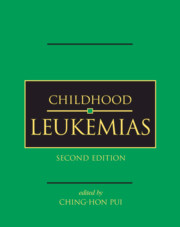Book contents
- Frontmatter
- Contents
- List of contributors
- Preface
- Part I History and general issues
- Part II Cell biology and pathobiology
- Part III Evaluation and treatment
- 14 Pharmacokinetic, pharmacodynamic, and pharmacogenetic considerations
- 15 Assays and molecular determinants of cellular drug resistance
- 16 Acute lymphoblastic leukemia
- 17 Relapsed acute lymphoblastic leukemia
- 18 B-cell acute lymphoblastic leukemia and Burkitt lymphoma
- 19 Acute myeloid leukemia
- 20 Relapsed acute myeloid leukemia
- 21 Myelodysplastic syndrome
- 22 Chronic myeloproliferative disorders
- 23 Hematopoietic stem cell transplantation
- 24 Acute leukemia in countries with limited resources
- 25 Antibody-targeted therapy
- 26 Adoptive cellular immunotherapy
- 27 Gene transfer: methods and applications
- 28 Minimal residual disease
- Part IV Complications and supportive care
- Index
- Plate Section between pages 400 and 401
- References
16 - Acute lymphoblastic leukemia
from Part III - Evaluation and treatment
Published online by Cambridge University Press: 01 July 2010
- Frontmatter
- Contents
- List of contributors
- Preface
- Part I History and general issues
- Part II Cell biology and pathobiology
- Part III Evaluation and treatment
- 14 Pharmacokinetic, pharmacodynamic, and pharmacogenetic considerations
- 15 Assays and molecular determinants of cellular drug resistance
- 16 Acute lymphoblastic leukemia
- 17 Relapsed acute lymphoblastic leukemia
- 18 B-cell acute lymphoblastic leukemia and Burkitt lymphoma
- 19 Acute myeloid leukemia
- 20 Relapsed acute myeloid leukemia
- 21 Myelodysplastic syndrome
- 22 Chronic myeloproliferative disorders
- 23 Hematopoietic stem cell transplantation
- 24 Acute leukemia in countries with limited resources
- 25 Antibody-targeted therapy
- 26 Adoptive cellular immunotherapy
- 27 Gene transfer: methods and applications
- 28 Minimal residual disease
- Part IV Complications and supportive care
- Index
- Plate Section between pages 400 and 401
- References
Summary
Introduction
Childhood acute lymphoblastic leukemia (ALL) has served as a model for cancer treatment for approximately five decades. With more precise diagnostic criteria and risk classifications, more effective therapy administered in controlled clinical trials, and better supportive care, the outlook for children with ALL has improved dramatically. Today, approximately 80% of children treated for this disease in developed countries will be cured (no evidence of disease for 10 or more years). Remarkably, this high cure rate is achieved mainly by optimizing risk-directed therapy, using the drugs that were discovered before 1980. Because of the ease with which samples of leukemic lymphoblasts can be obtained from the bone marrow and blood, laboratory studies of childhood ALL have consistently been at the fore of efforts to elucidate the principles of cancer cell biology. This chapter attempts to integrate advances in the biological understanding of ALL with basic principles of clinical management.
Pathobiology and pathophysiology
Leukemic transformation of hematopoietic cells requires subversion of the controls of normal proliferation, a block in differentiation, resistance to apoptotic signals, and enhanced self-renewal. The prevailing theory of leukemia pathophysiology is that a single mutant hematopoietic progenitor cell, capable of indefinite self-renewal, gives rise to malignant, poorly differentiated hematopoietic precursors. Several lines of research support the clonal origin of leukemia, including glucose-6-phosphate dehydrogenase enzyme studies and recombinant DNA analysis based on X-linked restriction fragment length polymorphisms in heterozygous females (whose normal tissues have a mosaic pattern of X-chromosome expression, yet whose leukemic cells show a single active parental allele).
- Type
- Chapter
- Information
- Childhood Leukemias , pp. 439 - 472Publisher: Cambridge University PressPrint publication year: 2006
References
- 7
- Cited by



